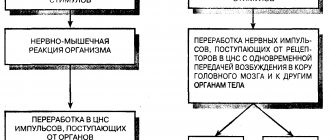“It was the third month since I worked under constant overload. I arrived at work 15-20 minutes late. Nobody made any comments to me about this. But it seems that if I were asked to explain myself, I would answer with the phrase popular on the Internet: “Sorry, I’m late because I didn’t want to come.” I didn’t have the strength or desire to get up in the morning, I set the alarm clock “for another ten minutes” 5-6 times. Of course, there was no time to even think about any morning exercises or meditation. I ate lunch at my desk, continuing to type something, and could even talk on the phone. I left work at ten o'clock with a feeling of total failure..."
— Vera, 29 years old, former objections manager
Have you often felt tired and apathetic at work lately? Or have you been experiencing these sensations for a long time, and they never go away? And even after a full vacation, the thought of the office or other usual activities causes anxiety and rejection? If so, you may be experiencing burnout syndrome.
Emotional burnout is a state of physical, emotional and mental exhaustion that occurs as a result of prolonged stress and systematic violations of work and rest. [1]
In the International Classification of Diseases (ICD-10), this emotional burnout syndrome is classified as a disease with the general name “Problems associated with difficulties in organizing a normal lifestyle” and is defined as “overwork, depletion of vitality.” [2] The process is closely related to work activity, but in its development it can also affect other areas of life: hobbies, relationships with loved ones, health. In this article we will talk about the causes of emotional burnout and how to recognize the signs of this condition. You will learn how not to go to extremes and be a productive employee while remaining a happy person.
Emotional burnout: what is it?
Emotional burnout or emotional burnout syndrome is a specific state of the human psyche, which is characterized by chronic physical fatigue, intellectual, emotional and nervous exhaustion.
Life in the modern world dictates its own conditions, so it is not surprising that every year emotional burnout is becoming more and more common. Those people who have to communicate with other people every day suffer especially.
When one person, fulfilling his work duties, communicates with another person, then, willy-nilly, certain emotions arise in him. Sometimes they have a positive character and warm the soul, but most often these emotions have a negative connotation and make the person who has them experience aggression, irritation, hatred or complete indifference. A victim of emotional burnout begins to perceive other people “according to a template”: they become a gray, meaningless and insensitive mass without any identifying marks, which one simply wants to erase from the face of the Earth or take the tenth route.
Most often, burnout syndrome occurs in those people whose professional activities are most directly connected with other people. This category includes educators, social workers, teachers, salespeople, managers, volunteers, doctors, cashiers, etc. But sometimes emotional burnout occurs not only at work, but also in family life, motherhood or fatherhood, creativity, etc.
Very often, many people confuse burnout syndrome with depression. But the second, unlike the first, at least does not cause cynical smiles on the faces of our compatriots. If a victim of the syndrome shares his experiences with family, friends, colleagues, acquaintances or not so familiar ones, then eight out of ten people will exclaim: “Can diseases have such ridiculous names? And how can emotions burn out? You just need to have a good rest in the company of friends and drink a couple of cocktails. As soon as you do this, all your emotions will immediately return to you!”
Few people realize that emotional exhaustion is a serious problem that can cause disruptions in the functioning of the body’s cardiovascular and endocrine systems and cause the occurrence and development of cancer.
Diagnostics
Only a specialist can correctly diagnose SEV. Diagnostics includes 3 stages:
- studying the patient's history and interviewing;
- laboratory research;
- testing.
First of all, the doctor studies the patient’s medical history, finds out the presence of chronic diseases and bad habits. Be sure to clarify the symptoms the patient is complaining about.
For a more complete picture, the doctor prescribes laboratory tests. Most often this list includes:
- general blood analysis;
- analysis to determine hormone levels;
- rapid test for liver and kidney function.
The main diagnostic method is testing, which was developed by the domestic psychologist V.V. Boyko. The test contains 84 statements to which the patient must answer “yes” or “no.” Based on the test results, the doctor will determine the phase of development of SEV. In total there are 3 phases.
- Voltage . The patient experiences conflict situations acutely. His anxiety level increases. He is dissatisfied with himself as a person. Feels backed into a corner. His psyche is struggling.
- Resistance . The patient begins to react to events inappropriately from the emotional side (screams, cries, breaks down, becomes hysterical). Some things no longer evoke emotions. More and more work tasks remain unfinished because he no longer considers them important. The psyche begins to give in.
- Exhaustion . In this phase, the patient experiences a deficit of emotions, detachment, and psychosomatic disorders. The psyche gave up completely.
If the patient does not take any measures, then one phase gradually gives way to another.
Causes and factors of burnout syndrome
Why does emotional burnout occur? One of the main reasons is the internal accumulation of negative emotions that do not find a way out. When a person is constantly in a stressful state, accumulates negativity in himself and does not get rid of it, then the personal and emotional-energy resources of such a person gradually begin to deplete.
A victim of burnout syndrome loses touch not only with other people and the outside world, but also with his inner self. Her existence becomes meaningless, pity for other beings gives way to indifference and apathy, and her quality of life deteriorates significantly.
Perfectionism is another cause of burnout. People who treat their work responsibilities without much trepidation, do their work carelessly and are supporters of the philosophy of not giving a damn, if they are familiar with this syndrome, then this acquaintance is clearly casual. But perfectionists, always striving for the ideal, are an ideal (pardon the tautology) target!
Such hyper-responsible individuals never refuse anyone, always agree to work overtime, feel pity for all people, react too emotionally to failures and failures (not only their own, but also those of their colleagues), perceive any criticism too sharply, etc. They, like a lover overcome by passion, are at first crazy about their work, but, not feeling any reciprocity, they gradually lose interest in it and become indifferent and callous crackers to everything.
If we consider the syndrome of emotional burnout through the prism of external and internal aspects, then the following factors influence a person’s emotional state: a stressful and overly nervous lifestyle, constant repetition of the same day (“Groundhog Day”), a feeling of hopelessness and one’s own uselessness, systematic criticism from friends and strangers, the constant presence of a “stick” and the absence of a “carrot”, alcohol, drug or nicotine addiction, sexaholism and craving for gambling.
Burnout syndrome can also occur due to a sedentary and sedentary lifestyle, childhood psychological trauma, the birth of a child, constant presence in closed rooms and rooms without windows, chronic insomnia, lack of personal life or hobbies, low wages, economic crisis in the country, age crises, etc.
Stages of emotional burnout
Most often, the syndrome occurs completely unnoticed by a person, so it can be quite difficult for him to determine where it all started. The entire process of emotional burnout can be divided into three stages.
➤ First stage
At this stage, emotions gradually become muted. It seems that someone has not only turned down the emotional volume, but also continues to keep their finger on the volume down button.
Indifference to the world around us begins to appear. Some people have an acute feeling of dissatisfaction with themselves and their lives. Life loses its colors and becomes gloomy gray.
Not only the psycho-emotional, but also the physiological state worsens. A person may experience causeless headaches. Problems with sleep arise: the victim of emotional burnout often wakes up at night, dreams of herds, and insomnia appears.
Problems such as pain in the neck, back and lower back, and cramps in the upper and lower extremities may also arise. All this negatively affects the immune system, so the risk of catching a cold or viral disease increases several times.
➤ Second stage
Emotional changes become more and more noticeable and tangible. A person who has been experiencing internal irritation for a long time turns into an angry and aggressive provocateur.
A victim of emotional burnout is rude to people around him for no apparent reason, may use obscene language in the presence of children, and refuses to communicate with family, friends and loved ones. At work, such an individual behaves passive-aggressively and does not show any activity while performing work duties.
At this stage of burnout, a person begins to neglect his own needs. He does not pay enough attention to himself and his hobbies, stops playing sports, spends more time in front of the TV, etc.
➤ Third stage
At the third stage of emotional burnout, a person no longer experiences any pleasure from work, family relationships, or life in general. Burnout occurs on both emotional and physical levels.
The victim of the syndrome turns from a cheerful, cheerful and perky optimist into a sad, angry, touchy, withdrawn and distant pessimist who does not care about anything.
The body of such a person is maximally weakened and exhausted, so he is susceptible to the development of a variety of diseases. In some people, at this stage of burnout, cancer cells begin to actively develop.
Encouraging initiative
Back in the late 80s. last century, the American company USDA Forest Service realized the importance of encouraging the initiative and innovation of its employees. Led by an executive named Floyd Marita, the company developed the "Spirit of Project" program, which proved that changing the organizational climate could have a beneficial effect on a company's productivity and financial position. Thus, reforming the corporate culture led to the fact that over 4 years, employees proposed more than 12 thousand innovative ideas, which ultimately helped optimize the company’s work, increase efficiency, improve customer service and reduce costs.
Research shows that employees who are not afraid to take initiative and take responsibility for the ideas they propose feel needed and have a clearer understanding of their place in the team.
Moreover, encouraging initiative on the part of management helps employees express themselves, reveals their creative potential and motivates them to further develop their abilities.
Symptoms of burnout syndrome
All symptoms of burnout syndrome can be divided into three groups: psycho-emotional, physiological and behavioral.
➥ Psycho-emotional symptoms include reactions such as lack of faith in yourself and your capabilities, a depressing feeling of loneliness, increased irritability and nervousness, chronic anxiety, pessimism, excessive temper, constant criticism of people around you, lack of respect for yourself and other people, depressed state , loss of motivation, bad mood.
➥ Physiological symptoms include the following reactions: chronic feeling of fatigue, constant weakness, apathy, general loss of strength, increased sweating, weak immune system, deactivation of the body's defense mechanisms, insomnia, sleep problems, frequent dizziness, decreased vision, causeless headaches, pain in muscles and joints, frequent occurrence of acute respiratory infections and acute respiratory viral infections.
➥ Behavioral symptoms include reactions such as the desire to be alone, the emergence of alcohol, drug, gaming, sexual, nicotine addiction, the active development of destruction of a professional nature, deviant behavior, the desire to evade responsibility for one’s own actions and deeds, envy.
Treatment by a specialist
If you have a mental disorder, you need to seek help from a specialist, he will tell you how to treat this condition. The psychotherapist first examines the patient, identifies the presence of a problem, and then determines the degree of its progression. Based on the results obtained, the doctor selects the most adequate treatment regimen. To achieve maximum effect, it is necessary to eliminate the factors that provoked the development of this pathology.
There are two ways to get rid of CMEA:
- Psychotherapy. During the treatment process, the patient is taught basic relaxation techniques, increases his emotional intelligence, and conducts various trainings that help him believe in himself and develop communication skills.
- Drug therapy. Symptomatic therapy is prescribed. In this case, antidepressants, nootropics, sleeping pills, and other medications are used that help alleviate the patient’s condition.
You need to share your problems with your interlocutor or a psychiatrist
Burnout at work
Burnout syndrome at work is a rather interesting phenomenon. Some people have never heard of this syndrome, while others, for whom work is the alpha and omega of their whole life, by the age of forty already have problems with excess weight, memory, eyes, heart and blood vessels, paint over their gray hair, see the dentist more often, than with their parents, they refuse sex and do not experience any joy in life.
Why is this happening? The thing is that some individuals are prone to emotional burnout at work. Such people have certain character traits: they want everything to always be perfect, they constantly take responsibility for everything that happens, they experience an unreasonable feeling of guilt, and they sacrifice their interests for the sake of other people.
Victims of burnout syndrome at work most often become people who are touchy, with high expectations not only for others, but also for themselves, living in a world of their own illusions, looking at the world around them through rose-colored glasses, wanting to please everyone.
Some workaholics may be in this state for several years in a row and not notice that their general health has deteriorated significantly, and life has turned into an endless series of monotonous everyday life. Some victims of the syndrome manage to be proud of their status as a perfectionist martyr and sincerely believe that such a life is the ultimate dream.
Such “immortal ponies”, which, unlike “horses dying from work”, sacrifice themselves for the sake of colleagues and superiors, expect the same sacrifices in return. But they just can’t understand that most people live for themselves, and not for others. False or unjustified expectations are another cause of emotional burnout at work.
Corporate life
An important point in the fight against emotional burnout is a friendly atmosphere in the team. Research results prove that informal communication among employees increases the sense of involvement in a common cause and increases motivation to work. The feeling of support from colleagues and empathy also help to resist emotional and professional burnout and fight fatigue.
It is possible to create a favorable atmosphere in the team with the help of corporate events.
It is not at all necessary to organize expensive and carefully organized corporate parties; it is quite enough to introduce a tradition of congratulating employees on their birthday, celebrating small successes of the company, and organizing informal picnics.
The fashionable expression “team building”, although it has become boring for many businessmen, nevertheless does not lose its essence and effectiveness. Appoint those responsible for the informal life of the company, encourage non-work events, introduce your internal corporate traditions.
Employee burnout
Burnout syndrome is most often observed in those people who hold responsible positions, constantly interact with other people, or want to save the whole world. Often creative people with a creative and non-standard type of thinking also become victims of the syndrome.
At risk are people working in the medical field (doctors, nurses, midwives, orderlies, ambulance workers), in the education sector (teachers, lecturers, educators), in the service sector (bartenders, waiters, service center and call center workers , managers), entrepreneurs, businessmen, executives, directors, directors, actors, designers, artists, etc.
Employee burnout is a widespread phenomenon. Japan had to introduce administrative and criminal penalties for systematic overtime and death in the workplace. In Russia, more than 75% of the total working population is on the verge of emotional burnout.
In many European countries, trade unions and occupational safety services closely monitor that employers comply with legal standards (you cannot overwork more than 220 hours per year compared to the norm of 1800 hours per year). And there is nothing strange in this, because 55–65% of all working days are lost precisely because of employee burnout syndrome.
Why do employees become victims of emotional burnout? There are many reasons and factors, the main ones being the following: great responsibility (real or invented by the employee himself), routine, economic decline, a large percentage of negative reviews, a strict system of fines and sanctions, tight deadlines, intrigues and conflicts among colleagues and superiors, frequent and sudden inspections, lack of respect, rudeness and rudeness, difficult working conditions, lack of a bonus system, low wages, lack of career growth, etc.
At-risk groups
The most common people who suffer from professional burnout are:
- those who work in the “person-to-person” field: teachers, doctors, salespeople, psychologists, bartenders, managers, trainers, administrators, flight attendants, call center employees, tour guides;
- introverts;
- representatives of difficult and life-threatening professions: firefighters, rescuers, police officers, air traffic controllers, military personnel, employees of crisis centers;
- businessmen, directors, managers, bosses;
- those who are forced to engage in low-paid work that does not bring pleasure;
- people of creative professions, when for a long time neither inspiration nor recognition from others comes to them.
Everyone who is at risk should regularly take preventative measures to prevent professional burnout.
I have an opinion. Some psychologists include a certain age group as a risk group - 27-35 years. This is a time of reassessment of values, changing life priorities. Professional interests fade into the background and give way to the desire to do something for the soul. I would like to have more free time, and not just earn money. Many at this age, assessing their position, begin to understand that it is nothing more than a source of income, but not emotional satisfaction. This kind of life position leads to burnout.
Mom's emotional burnout
Previously, emotional burnout was associated only with profession, career and work. Today it has already been proven that the syndrome can occur not only in the professional sphere, but also in family relationships.
The most common cause of such emotional burnout is the birth of a child. A mother who recently gave birth to a baby does not feel any moral satisfaction from family life. She gets the feeling that she is giving much more than she receives.
Everything a mother does is taken for granted and taken for granted. Few people compare maternity leave with work, but they have a lot in common. The only difference between the first and second is the weekend. They exist at work, but on maternity leave you have to work twenty-four hours a day, seven days a week.
Many young mothers become victims of emotional burnout syndrome due to lack of moral support from their husbands and relatives. Such women try their best to make sure that the baby is always under supervision, and the husband does not feel deprived of his wife’s attention, but it is very difficult, especially in the first year after the birth of the child, to combine one with the other.
A husband returning from work in the evening hugs his wife and says that he is very tired because he had a hard day at work. When his wife tells him that she is in the same condition, since she hasn’t had an easy day, because the baby is teething, the man shrugs his shoulders in bewilderment and smiles ironically, saying, you’ve been sitting at home all day, so what should you do? It’s a sin to complain about being tired.
After this merciless remark from her husband, the woman on maternity leave not only has an acute feeling of resentment, helplessness and hopelessness, but also a feeling of righteous anger. And it is this feeling that distinguishes mom’s emotional burnout syndrome from a depressive state, because depression is based on fear, not anger.
Many women who devote all their time to family and raising children sooner or later face emotional burnout. The main factors that provoke the occurrence of this syndrome include insomnia, the constant whims of the baby, a high level of workload with household chores, problems at school for older children, a difficult financial situation, debts, the constant absence of a husband, irregular intimate life or its complete absence , indifference of the spouse, lack of mutual respect between the married couple, unwillingness of the husband to take responsibility, constant interference of the mother, mother-in-law or other relatives in family affairs, unwillingness of the spouse to take on part of the household chores, etc.
Our inner voice screams
He screams desperately, but no one hears him. Some people are out of fear. The other one is out of disappointment. Depression and anxiety, which are very common in the 21st century, are the result of endless unfulfilled expectations and awareness of one's own powerlessness. We cannot directly control everything; a lot does not depend on us. But we are desperately trying, we are afraid of “not becoming a perfect cog,” and in trying to remake ourselves, to trim, to adjust, we are scared and sad - either because it doesn’t work out, or because the result did not bring satisfaction.
One slightly harsh, but very clear example. You are flying on a plane, and you are told that it is likely to crash. The wing is on fire, evacuation is impossible. What can you do other than just mentally take stock and say goodbye to your relatives? You can just sit and wait, your life is not in your hands. We can't control everything.
Advertising will be placed here
We are who we are. And events happen on their own, without us or with us. We can just jump into a boat and enjoy the journey from point A to point B. But if the waves are very seasick, we can jump off for a while and wait for a new boat to continue or change the route. And this is your world, you have the power to build yourself a bridge or a shore on which you can go. You don’t need to perceive such a stop as an exit into the open ocean, from which, of course, the only way is to the bottom. This is your world, your perception, your picture of the world - as you see, so it will be.
How to get out of emotional burnout: some practical and effective tips!
✔ Start resting properly
To get out of emotional burnout, you need to learn how to rest properly. This skill, regardless of the amount of money in your wallet, will not appear on its own. And among rich people there are many who sleep poorly, look 10 to 15 years older and have no internal reserves. Therefore, you should forget that you can only have a good and quality rest if you have a lot of money.
The thing is that not only the physical body needs rest, but also the consciousness. It, like the body, gets very tired from time to time. But the biorhythms of the body and consciousness do not always coincide. This is why many victims of burnout syndrome have problems sleeping: the body wants to sleep, but the mind still cannot switch off.
To synchronize biorhythms and have a good rest, it is recommended to turn off the TV and computer 2–3 hours before departure to the kingdom of Morpheus, put aside your mobile phone, tablet and other gadgets. It is also necessary to give up the evening news review, since there is so much negativity there that it will be very difficult for those people who do not have any problems with sleep to fall asleep later.
✔ Review your daily routine
A sedentary lifestyle is one of the main causes of emotional burnout. Mental work combined with emotions and sedentary work is a killer combination! By the end of the day, a person working in an office gets tired psychologically, but his physical strength is fine. The result is a kind of dissonance that negatively affects the nervous system and accelerates emotional burnout.
That is why it is necessary to reconsider your daily routine and increase your activity level. Sign up for a gym, swimming pool, oriental dance courses, etc. Choose the type of activity that you will enjoy doing, otherwise you won’t be able to do it for a long time.
If you don’t have the time, opportunity or desire to go somewhere after work, then develop the habit of walking in the fresh air every day for at least 60 - 80 minutes. And it doesn’t matter what the weather is like outside. Dress warmly if it's cold. And if it rains, take an umbrella with you.
Avoid alcoholic beverages, cigarettes, junk, sweet and fatty foods. Give preference to healthy foods that contain the required amount of proteins, slow carbohydrates, fiber, etc. Be sure to include vegetables and fruits in your diet!
Zoning of premises
Recently popular “open space” style offices often lead to workers suffering from a lack of personal space, suffering from headaches and even being psychologically repulsed by such a place of work, not feeling it is “theirs.” . This leads to dissatisfaction in the team, as well as staff turnover.
Psychologists say that proper zoning of work premises can reduce the likelihood of SEV manifestations by 30%.
If your office is decorated in an “open space” style, make sure that each employee’s workplace is closed from prying eyes on at least one side (wall, partition, closet).










